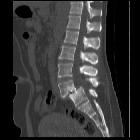Spondylolisthesis

















Spondylolisthesis (plural: spondylolistheses) denotes the slippage of one vertebra relative to the one below. Spondylolisthesis can occur anywhere but is most frequent, particularly when due to spondylolysis, at L5/S1 and to a lesser degree L4/L5.
Terminology
Although etymologically it is directionless (see below) and could be applied to both anterolisthesis and retrolisthesis, in practice, however, spondylolisthesis is used synonymously with anterolisthesis. Often, particularly in the lower lumbar spine, it is due to spondylolysis (pars interarticularis defects) .
To adequately describe a spondylolisthesis, both the type (see the classification of spondylolisthesis) and grade (see grading of spondylolisthesis) need to be stated.
History and etymology
Spondylolisthesis is from the Ancient Greek σπονδύλους (spondylous) meaning vertebra and ολίσθηση (olisthesis) meaning slippage .
Siehe auch:
- Spondylolyse
- anterolisthesis
- Wiltse Klassifikation der Spondylolisthesis
- anterior displacement measurement Taillard
- Schweregrad Spondylolithesis nach Meyerding
- Marchetti Bartolozzi classification
und weiter:
- Spinalkanalstenose
- Ehlers-Danlos syndrome
- Morbus Scheuermann
- Duraektasie
- retrolisthesis
- dural ectasia of lumbo-sacral spine
- conjoined nerve root
- umgedrehtes Napoleon-Hut-Zeichen
- Spondyloptose
- posttraumatische Spondylolisthesis
- pseudospondylolisthesis
- Alignment
- spondylolisthesis, spondylolysis
- Interartikularportion
- Napoleon-Hut-Zeichen

 Assoziationen und Differentialdiagnosen zu Spondylolisthesis:
Assoziationen und Differentialdiagnosen zu Spondylolisthesis:

